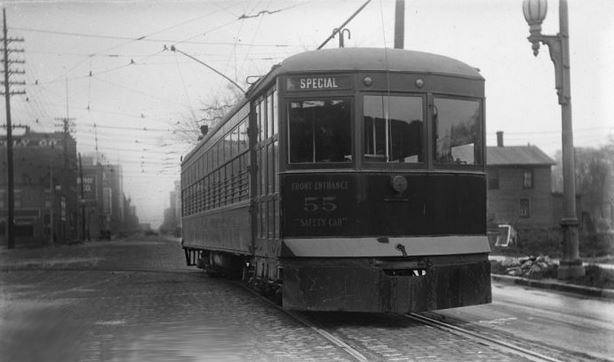
By Kris Leonhardt
Editor-in-chief
GREEN BAY – The electric streetcar, or trolley, first appeared in Wisconsin in Appleton in 1886 and slowly worked its way to Fort Howard and Green Bay.
The electric trolley system was often a city service, operated by public utilities and sometimes power plants.
In the fall of 1892, the city of Green Bay, and its mayor James H. Almore, were being romanced by several hopefuls who wished to bring streetcar service to the city.
Jackson I. Case and Charles H. Holmes, of Racine, were the frontrunners proposing a track on Main Street — from Main and 11th to the other side of the Main Street Bridge closed to the Northwestern depot — and on Walnut Street — from the Brown County Fairgrounds to Washington Street —on Washington Street — from Main to Mason Street and across the Mason Street Bridge — as well as a loop servicing Main and Monroe streets to Porlier, up Webster to Mason.
Some area residents, however, were leery of streetcars, afraid that they would frighten horses and prevent those in the country from traveling into the city.
And they had reasons for their concerns, as newspapers recounted incidents such as a February 1899 report of a “horse being driven by Matt Reily on Broadway” that was frightened by a streetcar and ran away.
Reily was thrown from his cutter and the cutter smashed.
Citizens and businesspeople with property on Main Street stood up to the council, urging them to relocate the line to Pine Street.
The council, at first, voted down the franchise, but on Sept. 16, 1892, the motion passed.
“Its provisions are the same as the one which preceded it. There is no project which has ever aroused greater interest in the city than this one and citizens generally are desirous of seeing it an accomplished fact which the coming season will secure,” a Press-Gazette article stated.
In the summer of 1893, second-hand cars from Racine were brought north and placed into service.
The operator of the streetcar stood in the front on a platform with little in the way of protection.
Passengers entered from the rear and paid their fare in “chits” (six for a quarter) in a box up front.
Chits were matched to the number of riders, and if the two didn’t line up the car would sit until it did.
Streetcar service ran every hour.
The Aug. 23, 1894, edition of the Green Bay Weekly Gazette announced the future arrival of the trolley in Fort Howard as the “Fort Howard Shake,” with local businessmen and legislators championing the cause at the city’s common council meeting the week before.
Those speaking at the council meeting scheduled to present the ordinance to create the trolley system saw it as “another bond drawing Fort Howard and Green Bay closer together and prove a strong factor in bringing about annexation of the two cities, a thing much desired by many people in both cities,” the article stated.
The ordinance passed, with just one alder opposing.
The franchise was granted to Fort Howard Banker David McCartney, who was also seeking an electric-light plant franchise at the time.
The ordinance provided that the construction of the road start in 90 days for a franchise term lasting 25 years.
In 1899 the two lines became one and Fox River Valley Electric Railway began handling transportation operations in Green Bay and Fort Howard.
That same year, vestibules were added to the cars to protect the operators.
In 1899, a railway was constructed to De Pere; followed by Duck Creek in 1902; and Kaukauna in 1903
“Trolley parties” became a thing in the Green Bay area, favored especially by women’s groups, as they took to open cars for their gatherings.
The streetcar company later created special lighted cars for the sole purpose of accommodating these groups.
On Nov. 17, 1937, the city officially said farewell to the streetcar after four decades of service, as thousands filled the streets as a half-mile-long parade moved down city streets to commemorate the “honorable discharge” of the trolleys.
During the celebration, Association of Commerce President J.M. Conway recalled the beginning of trolley service 43 years earlier, “When this city’s streets were paved with cedar blocks and brick, and the main industry was lumber manufacture, we looked down the river to Appleton where they had a contraption that hauled people around with an electric motor,” he said. “Chicago still had the wondrous horse-drawn vehicles. But we looked to Appleton, and all the arguments that were put forth didn’t prevent Green Bay from getting in line.”
The following morning, 12 new Wisconsin Public Service “streetliners,” or buses, moved down Washington and Walnut streets, making their inaugural run in the city.
